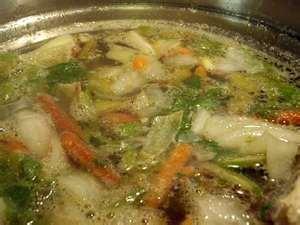Natural Year Challenge: Food - Month Two
Make a Meat Stock
 Welcome to the second step in our Natural Year Challenge! We'll begin our transition to a healthy, natural, and flavorful diet by making a meat stock. Meat stocks are extremely sustaining to the body and fight everything from cancer to arthritis, if quality meats are used.
Welcome to the second step in our Natural Year Challenge! We'll begin our transition to a healthy, natural, and flavorful diet by making a meat stock. Meat stocks are extremely sustaining to the body and fight everything from cancer to arthritis, if quality meats are used.
What is the difference between meat stock and broth? Broth is generally made by boiling meat only. Stock is made by boiling the bones, joints, feet (if applicable), and meat.
The key to nutritious meat stock is in the gelatin. In her book Nourishing Traditions, Sally Fallon writes:
Gelatin acts first and foremost as an aid to digestion and has been used successfully in the treatment of many intestinal disorders, including hyperacidity, colitis and Crohn's disease. Although gelatin is by no means a complete protein, containing only the amino acids arginine and glycine in large amounts, it acts as a protein sparer, allowing the body to more fully utilize the complete proteins that are taken in. Thus, gelatin-rich broths are a must for those who cannot afford large amounts of meat in their diets. Gelatin also seems to be of use in the treatment of many chronic disorders, including anemia and other diseases of the blood, diabetes, muscular dystrophy and even cancer.
Stock can be made with beef, fish, chicken, turkey, or duck. The following recipe for chicken stock is adapted from Nourishing Traditions.
Ingredients:
- 1 whole free-range chicken or 2-3 lbs. bony chicken parts such as necks, backs, wings
- Gizzards (optional)
- Chicken feet (optional) *
- 4 qts. filtered water
- 2 tbsp. raw apple cider vinegar (the acid helps release nutrients from the bones)
- 1 large onion, coarsely chopped
- 2 peeled carrots, coarsely chopped
- 3 celery stalks, coarsely chopped
- 1 bunch fresh parsley or handful of dried parsley
Cut chicken parts into several pieces and place into large pot (enameled cast iron is optimal; stainless steel is also an option). Add water, vinegar, and vegetables. Let stand 30 mins. to allow the vinegar to do its work. Bring to a boil and remove skim that rises to the top. Reduce heat, cover and simmer for 6-24 hours. Approximately 10 minutes before finishing the stock, add parsley. This imparts more mineral ions into the stock. Strain and refrigerate/freeze stock for later use. Or make a fresh pot of soup!
Stock keeps for several days in the refrigerator and six months or more in the freezer.
* Chicken feet make a wonderful addition to the stock. In a separate pot, boil several chicken feet for several minutes. Strain and cool. Clip off toenails and place in pot with the rest of the chicken parts. Chicken feet help create a nice gelatin. (Even if your stock does not gel, it is very nutritious!) Chicken feet may be available from your local butcher, and can also be purchased online from sources such as U.S. Wellness Meats.
In the following video, Andrea walks us through the process of making chicken stock, including (brace yourself!) cutting the toenails off chicken feet. If she can do it, so can you!
Bonus Challenge Tips: Healthy Meat Preparation
In her book Deep Nutrition, Dr. Catherine Shanahan offers these tips for cooking meat:
- Don't overcook. Steaks should be juicy and red.
- Use moisture, time, and parts. In other words, cooking meat at a lower temperature for a longer period of time makes a more nutritious, flavorful meal. Meat derives its flavor from its complexity. Slow-cooked meats are more nutritious because mineral salts are released from bone and cartilage during stewing.
- Use the fats. Buying organic grass-fed/pastured meats is crucial. Fat is an important source of energy since our cells consist of 30-80 percent fat.

